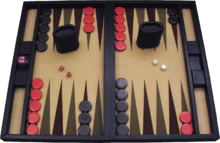
Back Bakspel Afrikaans Backgammon ALS Backgammon AN لعبة الطاولة Arabic Backgammon AST Nərd Azerbaijani نرد AZB Ҡыҫҡа нарды Bashkir Nardā BAT-SMG Кароткія нарды Byelorussian
 A backgammon set | |
| Years active | 1646 to present[1] |
|---|---|
| Genres | |
| Players | 2 |
| Movement | Contrary |
| Setup time | 10–30 seconds |
| Playing time | 5–60 minutes |
| Chance | Medium (dice rolling) |
| Age range | 5+ |
| Skills | |
| Related games | |
| Irish, Nard | |
| Origin: = 17th-century England Descended from: Irish | |
Backgammon is a two-player board game played with counters and dice on tables boards. It is the most widespread Western member of the large family of tables games, whose ancestors date back nearly 5,000 years to the regions of Mesopotamia and Persia. The earliest record of backgammon itself dates to 17th-century England, being descended from the 16th-century game of Irish.[2]
Backgammon is a two-player game of contrary movement in which each player has fifteen pieces known traditionally as men (short for 'tablemen'), but increasingly known as 'checkers' in the United States in recent decades, analogous to the other board game of Checkers. The backgammon table pieces move along twenty-four 'points' according to the roll of two dice. The objective of the game is to move the fifteen pieces around the board and be first to bear off, i.e., remove them from the board. The achievement of this while the opponent is still a long way behind results in a triple win known as a backgammon, hence the name of the game.
Backgammon involves a combination of strategy and luck from rolling dice. While the dice may determine the outcome of a single game, the better player will accumulate the better record over a series of many games. With each roll of the dice, players must choose from numerous options for moving their pieces and anticipate possible counter-moves by the opponent. The optional use of a doubling cube allows players to raise the stakes during the game.
© MMXXIII Rich X Search. We shall prevail. All rights reserved. Rich X Search